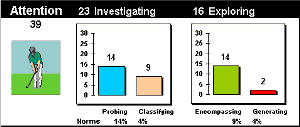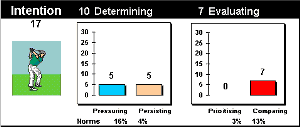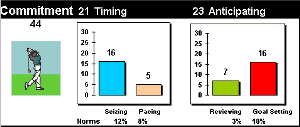| Interaction
|
|
A unique feature of the
Action Profile® is the effect of an individual's interaction style at each
stage of the decision making process.
The differing interaction
styles (there are 9 variations for each stage of the decision making
process) have enormous implications for both individuals and teams.
|
You
will notice that we have added a background pattern or colour to the
graphs on the Footprint. This background represents how the individual
is likely to interact with others at that stage of his decision process.
It gives an indication of whether the individual wants to share the
process with others or whether he has a need for independence of
thought.
|
|
|
| Share/Versatile
Interaction in Attention
|
|
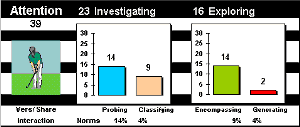
|
When
he is gathering information or exploring alternatives Tony is equally
comfortable working through the process with others as working
independently, although most of the time he will prefer to seek input
from others as share his own thinking thereby creating a good
environment for innovation. His inclination for independence of thought
on occasion could lead to confusion in others who may sometimes wonder
if their ideas have been heard.
|
|
|
|
Versatile Interaction in
Intention
|
|
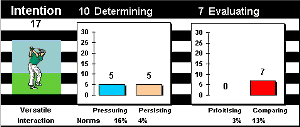
|
Here,
at the point of decision, Tony can provide support for building
mutual agreement or allow equally for independence of thought. Again
this can be confusing for others who may feel uncertain of where they
stand with him or lacking clarity over what his intentions are.
(More
than half the senior managers profiled are more inclined to make
decisions on their own and run the risk of not building joint resolve
with their colleagues. With this understanding it is not difficult to
see why real commitment to decisions in meeting is difficult to achieve.
This is easy to overcome with simple facilitation techniques relevant to
this issue).
|
|
|
|
Private Interaction in
Commitment
|
|
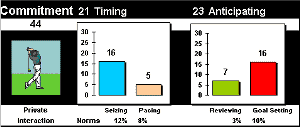
|
Tony's
privacy in the Commitment Stage of the decision process leads him to
'just get on' with what needs to be done, regardless of what others
think. He likes to work independently and does not think to tell
people what he is doing. This can feel like he really takes care of
things, equally it can create suspicion and seem manipulative to others.
He is in danger of springing surprises on his colleagues when he has
gone off and done things that they were not ready to commit to and have
no idea that he has done it until too late.
|
|
|
|
Tony's Case History
|
|
Tony
has always been excited by new ideas and has diverse interests which he
actively pursues. As a child he was always persuing projects
(privately) in a shed at the bottom of the garden. His inventions
worked.
As a research director for a large engineering company, he found himself
constantly frustrated by the desire to get things done that he could see
were absolutely necessary because he foresaw the future trend. He
found himself either being held back by his colleagues, or, more often
going ahead on his own without thinking to tell anyone what he was
doing. This often resulted in friction between himself and other
areas of the business. His ideas, eventually, were mostly seen to be
necessary, however much time and resources were lost because of inadequate
communication.
When Tony finally had the opportunity to set up his own engineering
consultancy business he was able to set up a laboratory/ workshop - known
in the company as "Tony's shed". Being free to act in
accordance with his underlying natural talents particularly in terms of
decision process, has enabled him, within a year, to have a turnover in
excess of £1,000,000.
Acknowledgement and understanding of his own personal strengths through
this system has enabled him to make the most of his talents and find
coping mechanisms for the areas that require more effort from him.
|
|
Please
note that this account represents a very brief summary of one or two of
the key findings in this profile.
|
See the impact
of Interaction
on a team on the next page
|
|
|
|
|
<< Top
<< Previous
Page Home
Page Next
Page >> |
Copyright © 2002 Interact Development Limited. All rights reserved.
Revised: October 27, 2002
. |





